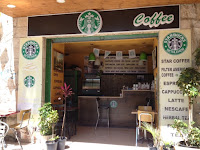Asia at last! On the overnight flight from London my luck was in; a full row to relax and watch sleepily as we flew through dawn skies over sea & desert to Uzbekistan. I spent my first morning in Tashkent but the capital didn’t have the sights & experiences I’d come for and the airport taxi I took crashed into another car. An earthquake in the 60’s gave Soviet planners carte blanche to carve out marble-lined boulevards and create towerblocked suburbia. Only the metro gave respite; beautifully tiled, slightly kitsch and out of the sun.
Hotel Uzbekistan, Tashkent
I reached Samarkand an hour before sunset and settled into a guesthouse run by a lovely lady who mothered me a little. I spent the evenings sat around a quiet courtyard with local beers & china bowls of tempura. Amid the one-upmanship conversations of Dutch backpackers & Latvian journalists, “When I was mountain trekking in Bhutan…” I tried my usual trick of hinting that I was a spy, spinning intrigues in my own personal update of the Great Game. As ever, no-one bought it.
The Registan is the tourist-friendly face of Samarkand, both rich in detail and more dazzling now than at any point in history. A viewing platform even frames the scene; making it almost impossible to take a bad photo. The issue of architectural restoration is a contentious topic in all the Uzbek Silk Road cities & it gives a homogenous shine which is both camera-friendly & historically distorted.
I spent two days in Samarkand, in & out of mosques & mausoleums, all glittering with rainbows of mosaics and honeycomb recesses. In the Gur-i-Emir, Tamerlane’s tomb was represented by a single jet-black slate in a chamber of high arches overhung by waves of lilac tiles. I changed currency in a dim antechamber, counting out notes on a tomb & spent my cash on the same thick rings of bread that traders on the medieval Silk Road ate, tearing off chunks and sweetening with soft cheese.
Tomb of Tamerlane, Samarkand
From Samarkand to Bukhara; two fabled cities connected by a slow & stifling afternoon train. Where Samarkand’s impact was visual, Bukhara’s is historical. In the 19th century the Great Game kicked off in earnest when two British spies were dragged from a tick-ridden prison pit & beheaded in the town’s square. After posing on a Bactrian camel so I could send a selfie to my parents [who had no idea I was in Uzbekistan], I walked round the sun-baked mud walls to the prison, peering down into the pit where the spies, Connoly & Stoddart, spent their final days. The Ark fortress, where the evil Emirs ruled, was now stripped of character & had none of the stunning impact of the town’s other Maidan where a turquoise-domed madrasah & imposing mosque offset a slender brick minaret.
I bought a dusky-red Bukhara carpet from Sabina who was familiar from an old edition of Globe Trekker. She made me tea & asked my budget. “$200.” She looked offended and pointed to a stack of tiny rugs in the corner. The wily Sabina had the only working ATM in the country in her shop & my ineffectual haggling was no match for her business acumen.
I flew from Bukhara to Khiva and, swerving the taxi drivers, took a trolley-bus into the ancient walled city. A mother dropped her swaddled baby as I sat down, astonished at the sight of a foreigner on the bus. The crying child rolled down the aisle. My hotel was the Orient Star, a restored Madrasah; student cells made over with modern plumbing and set around a courtyard. Under cobalt-noon skies, birds swooped & dived, relieved at sunset by bats, lapping in the thickening dusk. Fronting the hotel a stumpy green-tiled minaret gave Khiva its postcard image, as if a giant copper burrowing machine was stuck fast and had rusted in the earth.
Orient Star Hotel, Khiva
All the Silk Road cities had been restored but Kihva’s was the most meticulous and it felt as if real life had been neatly brushed away at times. On Sunday, it was heaving with local tourists. Throughout this trip I was approached by Uzbeks from all walks of life who wanted to practice their English & take photos. Some barely spoke hello, while others were more fluent than I was. In Khiva, it reached its zenith and I became a tourist attraction for teenagers, schoolteachers, businessmen, and weirdly, grandmothers; all clicking camera phones at my middle-aged ruggedness. There are hundreds of photos of me in Khiva, but I didn’t take any of them.
Uzbekistan felt like old-school backpacking at times; no atms [unless you want to buy a carpet], Wi-Fi that floated on the breeze and a plug socket in Samarkand that almost blew my arm off. Worries about bureaucracy were unfounded. My only brush with authority was a single shrill whistle as I photographed a memorial to Soviet astronauts in Tashkent, followed by a wagging finger. The very names of these Silk Road cities are evocative; Samarkand, Bukhara, Khiva. Standing in their perfect squares and gazing at the madrasahs & minarets & mosques, it was often impossible to see where original decoration ended & restoration began and although that detracts from authenticity, it looks absolutely stunning.
























